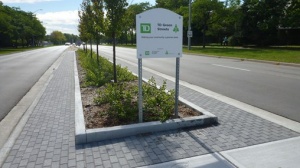Roadside safety
Streets are both a barrier to natural hydrology as well as an opportunity to manage stormwater. This page discusses roadside safety concerns associated with road right of ways (ROW). For more information on stormwater management for road right of ways, please see the Site conditions road right of ways page.
Green street design integrates stormwater control and management within the right of way and ensures that the street remains functional and safe for users during a storm event. Unlike stormwater management features such as stormwater ponds that can be isolated or fenced off, LID road right of way retrofits are directly integrated into the existing built form therefore, it is critical to consider how the project will affect all users of the right of way. When incorporating green infrastructure into street design, it is important to design with attention to citywide traffic safety and mobility.
Although, the ROW is typically seen as a transportation corridor, it is important to consider other processes which influence the way a community functions such as:
- Sidewalks and bike lanes are common along urban cross-sections and may also be found in rural cross-sections
- Storm sewers and sanitary sewers are buried within the ROW
- Utilities such as electrical and communications lines are either strung overhead or buried in trenches within the corridor
- Roads may be within existing or planned public transportation routes which may affect available space for LID features
- Access to private properties by emergency vehicles including fire trucks must be considered
- Interactions with adjoining land uses
When assessing the roadside safety of the retrofitted road right-of-way, it is important to evaluate roadside safety of the existing as well as the proposed conditions. It is also critical to consult with existing design standards (such as the Ministry of Transportation (MTO) Roadside Safety Manual and the Geometric Design Standards for Ontario Highways) when assessing roadside safety.
It is recommended that the following points be taken into consideration when assessing roadside safety in accordance with the MTO Roadside Safety Manual:
- Concrete barrier curbs are typically used as borders for road medians and are not considered to provide protection for design speeds greater than 60 km/h as vehicles travelling at such speeds are likely to hop over the curb rather than be redirected
- Planter walls oriented transversely to the roadway and taller than 150 mm as well as dislodged precast pavers may be frangible and are known to pose a hazard to vehicle traffic
- If the entirety of the median is narrower than the required clear zone, additional care should be taken to not construct any hazards in the median
- Median ditches should have transverse slopes as flat as possible but no steeper than 4:1
- Ponding depth in LID features between rainfall events should be kept to the minimum as in the event of a vehicle rollover, drowning is possible even in shallow depths of standing water
- Although there is no specific tree diameter criteria in the MTO Roadside Safety Manual, wooden posts with diameters of 150 mm or less are categorized as frangible by the manual. It is recommended that any tree species planted in the LID feature should have a maximum trunk diameter of 150 mm as larger diameter trees pose a hazard to vehicle motorists
- Trees cannot be planted too close to the roadway and should be spaced such that an errant vehicle will only strike one tree at a time to avoid causing rapid deceleration
Sightlines[edit]
When constructing plantings directly adjacent to roadways, it is important to avoid obstructing the required sightlines as set out in the MTO Geometric Design Standards for Ontario Highways. Under the standard, there are various types of sightlines such as stopping, intersection, passing and decision sight distances that must be met depending on the scenario at hand. Of the various sightline types, adequate stopping sight distance must be provided at all intersections and roadways so that a vehicle must be able to see far enough ahead to perceive an object, react to it and bring the vehicle to a stop before reaching the object in question. Maintaining intersection sightlines at signalized and non-signalized intersections is also required to allow motorists the opportunity to mitigate collisions at intersections. Depending on the site conditions, the extents of intersection site triangles are prescribed in the MTO Geometric Design Standards for Ontario Highways. It is also important to account for the height of vegetation at each LID site as the height should be coordinated such that drivers are given a reasonable view of the intersection where they can see cross-traffic when approaching the intersection.
